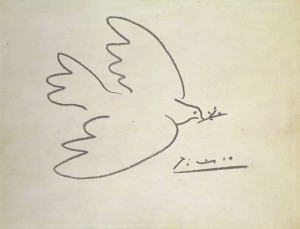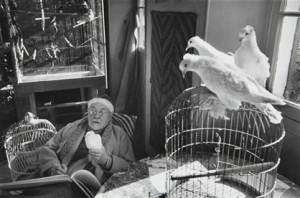One of Picasso’s most famous and popular images is his lithograph of a dove as a symbol of peace. But the dove was Matisse’s. Literally.
Matisse and Picasso first met at the salon of the American patroness and writer Gertrude Stein’s in the early 1900s. At the time they were rivals for both her affections and those of the modern artists of Paris. Picasso’s followers once plastered the walls of Montmartre with anti-Matisse graffiti like “Matisse drives you mad!” and “Matisse does more harm than war!” Matisse responded by using the term “Cubism” to mock the art of Picasso and his followers, a label that would, of course, stick.
As they grew older, they grew closer. By the end of World War II, the old rivals had truly become great friends. Matisse was now almost eighty, nearly bed-ridden and living in apartments in Vence, a town close to Nice. His wife, Amelie, had recently divorced him; his children were grown with children of their own. His bedroom and studio were filled with birds and plants to keep him company and inspire him.
Picasso, along with his mistress, Francoise Gilot, was a regular visitor whenever they came south. They often exchanged paintings and even exhibited together. Matisse kept a Picasso over his bedroom’s mantelpiece and Picasso displayed his Matisses in his studio. Picasso, who was eleven years younger, would bring recent paintings to Matisse for comments. An engraver who did work for both of them said Picasso thought of Matisse “as an elder brother.” Matisse thought of his rival as “the kid.” Their arguments continued, but more like sibling rivalry as they sat alone at the pinnacle of the art world.
When Matisse took on his last great commission — the chapel of Vence — he emptied his living quarters so he could cover the walls with brightly colored cut-papers and not be distracted. He bid a sad farewell to the plants that one can see in so many of his paintings. His exotic pigeons were sent to Picasso.


